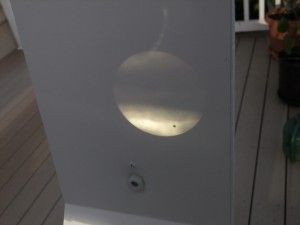Belated 2012 Transit of Venus report
Although most of the posts you see on this blog are about electronics, hence the name: Elabz, I can’t resist the urge to post about of my other hobbies here. I haven’t done it before in all of the three year history of this blog but from this point onward my visitors are going to have to endure a non-electronics post every once in a while.
Astronomy is one of those not-yet-covered-here hobbies of mine and one of the rarest, easy to observe and just overall interesting astronomy events has just happened recently – the June 5, 2012 Transit of Venus. Since I had a camera handy, I had to snap some pictures and brag about it here 🙂 It was the very first time I saw an image of the Sun projected through optics and it was a rather illuminating experience, pun totally intended.
The setup was very easy and took me just 20 minutes to put together. I opted for a projection setup because I wanted to share the view with my family members and the idea came from the Exploratorium website. I actually had a 40x monocular with a 1/4″ thread attachment, which made it very easy to mount onto a regular photo camera tripod. I used masking tape to affix a piece of cardboard with a hole in the center to the monocular. The hole is the same diameter as the monocular’s body at it’s largest cross-section and the cardboard’s only purpose if to cast a shadow onto the screen behind it. The cardboard shade is optional but it does increase the contrast of the picture, I would recommend doing it if you are repeating this setup with bi- or monoculars. The projection shows on a piece of white foam board I have mounted on another, smaller photo camera tripod that’s behind the one with the monocular. The trick here is to tilt the screen in the way that it’s perpendicular to the optical axis of the monocular.
A little safety tip: use a sharp craft knife to make a thin notch in the cardboard shade at the top of the center hole and use it as a visual guide when you first position the monocular. NEVER LOOK DIRECTLY AT THE SUN THROUGH THE MONOCULAR! Only the projected image can be viewed safely!
Since this is a completely manual setup, you get a renewed appreciation for just how quickly the Sun goes around the sky: it goes out of view pretty much every minute of so when viewed with the 40x monocular and you have to adjust it both down and clockwise (it was just before sunset and I’m in the North Hemisphere 🙂
In conclusion, Sun watching turned out to be a fun and an educational experience, very interesting for adults and kids alike. It’s also very safe, the safety precautions for positioning of the monocular noted. Since this setup produces projected image that everyone around sees, you can point to the parts of the image explaining where the Sun spots are and in this case Venus’s shadow added yet another point of interest to an already interesting image of our Sun.By the way, can you actually spot Venus on the picture to the left? Do not pay attention to the pointing finger!




